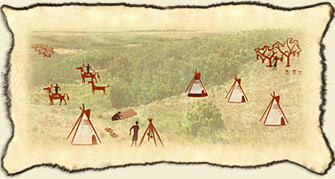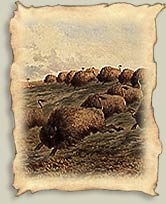|
|

How we lived with the Land
Gathering Berries
After the ceremonies ended, the large camp broke up and clans moved away. As chokecherries ripened, people moved to locations that were known to have thick patches of these bushes. These were dried and stored for the winter. |
|
|
 |
Chokecherries
Chokecherries ripen in late summer. Dried cherries were important food because they are rich in
vitamin C.
Chokecherries grow on high ground that is well drained. We had favorite places where the plants were most abundant. Because we picked so many chokecherries, some would be dropped and grow into new plants. If one site had a poor crop, we knew of many other we could go to. We always made an offering to the plants and thanked their spirit for allowing us to pick the chokecherries.
 |
 |
Annora Brown,
Choke Cherry (Prunus melanocarpa), 1960,
Collection of Glenbow Museum
|
| |
|
 |
|
 |
Camp Site During Summer
After the circle camp, the clans moved across the plains. In late summer, camps were places of relaxation. Sun shades were made by leaning two travois together and draping a buffalo hide over them. People visited and often traveled to other camps to see friends and relatives.

|
 |
Glenbow Archives NA-249-78
|
| |
|
 |
|
 |
Hunting Buffalo
In the late summer and early fall we hunted buffalo. The meat was dried for our winter food supply and the hides were used as warm robes in the cold weather.
Sometimes several clans joined together at a pisskan (buffalo jump) and herded a large number of buffalo over a cliff. This gave us plenty of meat for winter.
The deer and buffalo were also fat and in good condition for hunting.

|
 |
Frederick A Vemer,
The Stampede,
Collection of Glenbow Museum
|
| |
|
 |
|
 |
Drying Meat
In the autumn our women dried as much meat as they could. This was our food supply for the winter.
Buffalo , deer, and elk meat were dried by cutting it into thin strips and hanging them over a rail. The sun quickly dried the meat, preserving it for a long time. The wind kept flies and other insects away. Our women were always chasing young boys and dogs away from the drying meat.

|
 |
Gerald Tailfeathers,
Winter Meat, 1960,
Collection of Glenbow Museum |
| |
|
 |
|
 |
"While I was out hunting I saw many buffalo bulls. They are too far away to hunt and bring the meat back to camp."

|
"We have picked most of the chokecherries here and there is not much game around. Tomorrow we will move camp to be closer to the buffalo. Their tough hides will make good shields and rawhide containers."
 |
 |
|
|

